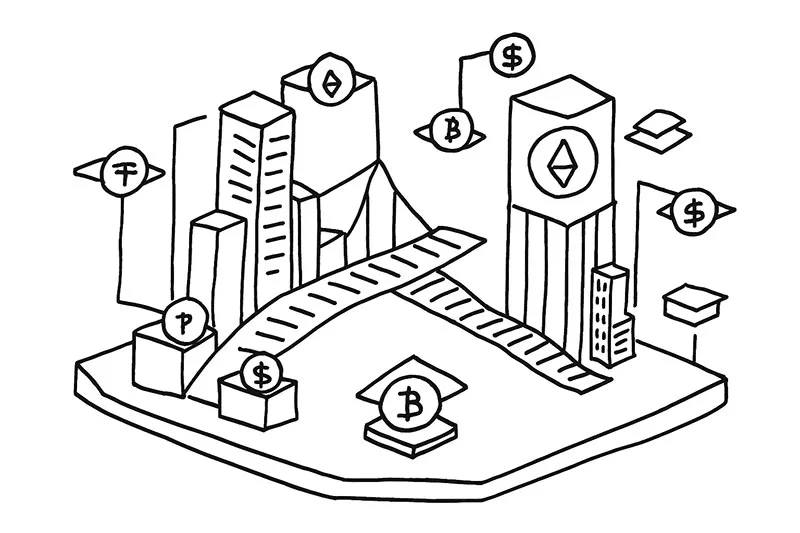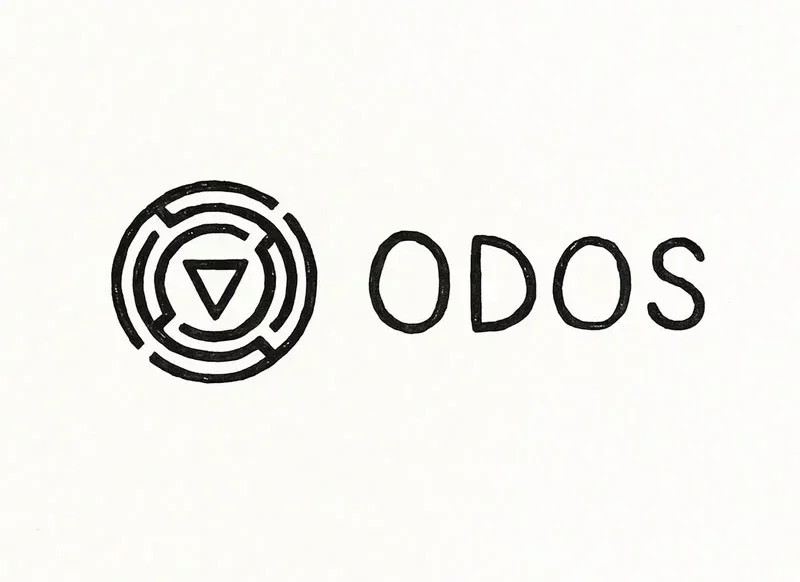In a world where blockchains are multiplying and decentralized exchanges are emerging daily, one major problem arises: how to find the best price when liquidity is spread across hundreds of platforms? Imagine instead of one giant supermarket, you have a hundred small shops scattered across the city, each with its own price for bread. It would be inconvenient and expensive to search for the best deal. This is the problem Odos solves – a platform that offers a unique approach to trading.
DEX Aggregator: Your Guide in the Exchange World
What is a decentralized exchange aggregator, or DEX aggregator? Simply put, it’s your smart search engine for crypto trading. Instead of manually checking each exchange for the best price, you just turn to it. It scans hundreds of platforms simultaneously and finds the optimal route for your trade through a single, user-friendly interface.
It’s like a big shopping mall: you go to one place to see offers from multiple stores selling the same products. You don’t have to visit each store separately – you see all the options at once and can easily compare prices.
Smart Order Routing: GPS for Trades
Behind this simplicity lies a complex technology called Smart Order Routing (SOR). Imagine it as a GPS navigator for cryptocurrency trades. It doesn’t just show the shortest path from one coin to another, it finds the fastest and cheapest route among hundreds of possible options. It takes everything into account: “traffic jams” in the form of high fees, “detour roads” through other exchanges, and even “speed” – the speed of trade execution.
How does it work?
- The system constantly scans multiple trading platforms.
- It evaluates prices, liquidity, fees, and the likelihood of your trade being completed without delays.
- To prevent price slippage, large orders are split into smaller parts and distributed across different exchanges.
- Ultimately, the system selects the optimal platform or combination of platforms to get you the best result.
Odos’ Unique Algorithm: Non-Linear Paths and Atomic Swaps
Most aggregators work on a simple “token A to token B” scheme. But Odos goes further. Its algorithm, based on an advanced version of pathfinding algorithms, looks for non-linear trading routes. Instead of a straight “A → B” path, it might find a more profitable “detour” route, like “A → B → C → D”, if such a multi-step trade ultimately gives you more coins. It’s like finding the shortest path in a maze, where the walls are different exchanges, and the distance is measured in cost and transaction time.
And most importantly, Odos consolidates all of this within a single, indivisible atomic transaction. Imagine it like a light switch – it’s either on or off, with no intermediate states. If any part of the complex multi-step trade fails, all funds are returned to the owners, and no one loses anything.
This allows Odos to offer a unique opportunity – multi-token swaps. You can exchange several different coins from your wallet for several other tokens in one operation, rather than five or ten separate trades. This not only saves your time but also reduces gas fees, while completely eliminating the risk of partial execution.
Results: What’s Behind This?
Since its launch in April 2022, Odos has become one of the largest trading platforms in the crypto world. During this time, it has:
- Processed a cumulative trading volume of over $73 billion.
- Served over 3 million unique wallets.
- Achieved monthly trading volumes exceeding $2.6 billion.
This is impressive, as Odos reaches volumes comparable to major traditional exchanges, but does so entirely in a decentralized manner. Ultimately, this isn’t just a technological platform. It’s a tool that simplifies the life of the crypto trader, making the world of decentralized finance more accessible and efficient.
Who is Behind Odos: The Team at Semiotic Labs

In a world where blockchains are multiplying and decentralized exchanges are emerging every day, behind every truly successful product, there is always not just an idea, but a team. And in the case of Odos, this team is a truly unique phenomenon. It is backed by Semiotic Labs, and their story deserves to be told separately.
Semiotic Labs is not just a startup; it is, as we would say, a high-tech R&D laboratory, founded in 2020 in Silicon Valley. The lab specializes in the intersection of cutting-edge technologies: artificial intelligence, zero-knowledge cryptography, and blockchain infrastructure. Imagine a team combining minds from Google DeepMind, encryption specialists from military labs, and leading blockchain developers.
Ahmet Ozcan: From Scientist to Web3 Visionary
At the helm of this team is a person with an entirely atypical background for the crypto world – Ahmet Ozcan. He’s not just a programmer or businessman, but a true world-class scientist.
Ozcan earned his bachelor’s degree in physics and then completed his Ph.D. at Boston University. His doctoral work led to the discovery of a new type of texture in thin films, and this discovery was published in the prestigious journal Nature – a sort of “Nobel Prize” in the world of science.
But his story doesn’t end there. He spent over 14 years working at IBM Research, rising from a young researcher to a top executive leading AI development teams. During this time, he earned the highest recognition – the title of IBM Master Inventor – and became the author of over 100 patents in AI and digital security, publishing more than 50 peer-reviewed scientific articles. This means he created over 100 new technologies that didn’t exist before and gained recognition in the most authoritative scientific circles.
In 2020, Ahmet Ozcan made a risky but incredibly bold move: he left a well-paid job at one of the world’s largest corporations to found Semiotic Labs and develop future technologies in the emerging Web3 space. This was a transition from a world of stability to one of innovation.
The Dream Team: Who Else Is Behind the Innovations?
Of course, one person can’t do everything. Alongside Ahmet Özcan is a team of exceptional talents:
- Yuri Papadin, Co-founder and Chief Operating Officer, is responsible for ensuring the company runs like clockwork, managing all business processes and securing strategic partnerships.
- Matt Dable, Co-founder and Head of Research, is the chief technical brain, creating the complex algorithms that make Odos outperform its competitors.
- Sam Green, Co-founder and Head of Research, is an expert in the most advanced forms of encryption and AI, previously working in secret government labs in the U.S.
Dual Expertise: Why Does This Matter?
The uniqueness of Semiotic Labs lies in the fact that they are simultaneously:
- The main developers of The Graph – a protocol that can be compared to “Google for blockchain” and has a market capitalization exceeding $1 billion. For their work, they received a $60 million grant for 8 years.
- The creators of Odos – the leading DEX aggregator with billions in trading volumes.
It’s like one team simultaneously created both Google (for information search) and Amazon (for trade) – two different yet complementary technologies. This enables them to apply the same AI tools that Google DeepMind used to beat the world’s best Go player to solve problems in the crypto world. Imagine using space technology to improve cars.
What’s more, Semiotic Labs not only created a working product but also patented their key technologies while making them available to the entire community. This rare combination of innovation and openness sets them apart in the market.
Innovations: How Serious Are They?
Semiotic Labs has filed patent applications for key Odos technologies, specifically for the “System and Method for Smart Order Routing and Pathfinding for Decentralized Automated Market Makers.” This shows that the team didn’t just create a working product, but legally protected their innovations, indicating the seriousness and long-term nature of their plans.
However, all intellectual property and products are open under The Graph Protocol license. This means that despite the patents, the team makes its technologies available to everyone – a rare blend of innovation and openness.
This team is not just a group of enthusiasts. It’s a fusion of science, business, and technology, creating products that are changing the game.
Liquidity Fragmentation – The Main Pain Point of DeFi

The main issue that motivated the creation of Odos was liquidity fragmentation in the decentralized finance (DeFi) ecosystem. As Ahmet Ozcan explained in an interview, the team was “frustrated by the experience on decentralized exchanges” due to this fragmentation, which was “irritating.”
Specific Problems Identified by the Team
Suboptimal Price Discovery
Existing DEX aggregators were unable to find the most efficient trading routes, especially complex, so-called non-linear paths. They worked with a simple “Token A → Token B” scheme, like a primitive GPS that only shows a straight road. But sometimes the route “home → gas station → store → work” might be faster and cheaper due to traffic and toll roads. Old aggregators simply ignored such “detour roads.”
Limited Multi-Token Capabilities
Traditional aggregators required users to perform multiple separate transactions when rebalancing portfolios or making complex trades. If you wanted to exchange five different tokens for three others, you had to execute 5-8 separate operations. It’s like being forced to stand in a separate line for each item in your cart at a supermarket – one line for bread, another for milk, another for meat. It’s very inconvenient, time-consuming, and, most importantly, costly in terms of fees.
Computational Complexity
Finding optimal routes across hundreds of liquidity pools and multiple blockchains required such complex algorithms that existing solutions simply weren’t enough. It was necessary to analyze millions of possible paths and find the best one. Imagine a chess player who has to calculate not 3-4 moves ahead, but millions of possible combinations simultaneously. The human brain can’t handle this, it requires a supercomputer with advanced algorithms.
Inefficient Gas Usage and MEV Attacks
Multiple transactions for portfolio management led to excessive gas costs and increased MEV (Maximum Extractable Value) attacks. Each separate transaction is an individual fee and a new opportunity for bots to steal your profit. MEV occurs when bots see your trade in the queue and quickly buy tokens before you, then sell them back to you at an inflated price. The more separate transactions, the more opportunities for such attacks.
The Physicist’s Revelation: How the Idea Was Born
As Ozcan himself noted, his background in physics played a key role here: “With my experience in physics, optimization has always been important to me. So, I started focusing on decentralized finance and optimizing routing to solve the fragmentation problem.”
In simple terms, Ozcan applied the same mathematical methods used in physics to cryptocurrencies to find optimal paths. For example, just as light always takes the shortest path, or water always flows through the path of least resistance. He saw in the chaos of decentralized finance a fundamental optimization problem that could be solved through science.
The Solution: A Single Entry Point
Liquidity fragmentation made DeFi expensive, slow, and inconvenient. Odos was born as an answer to these problems – an aggregator with a smart algorithm that “weaves” the fragmented market into a unified, efficient route for any trade.
Instead of forcing users to deal with hundreds of exchanges and protocols, Odos provided a single window for accessing all of DeFi’s liquidity – like turning 1,000 scattered shops into a single convenient shopping mall with the best prices, where you can buy everything you need in one transaction, saving time, money, and hassle.
Why Odos Is Better Than the Rest

In the world of DEX aggregators, where competition is incredibly high, standing out can only be achieved by offering something unique. And Odos has managed to do just that. While most competitors are excellent but specialized tools, Odos is, as we would say, a universal Swiss knife that does everything – and does it better.
Advanced Algorithmic Optimization
The main difference with Odos is its patented algorithm, which searches for non-linear paths. Imagine two GPS navigators. The regular one, like most competitors, only shows the direct route from point A to point B. But Odos’ GPS is an advanced version that can find a route like “home – gas station – store – work” if it turns out to be faster and cheaper due to traffic on the straight road.
How it works?
Traditional aggregators search for a direct path: Bitcoin → Ethereum.
Odos, using advanced pathfinding algorithms, can find a detour route: Bitcoin → USDC → LINK → Ethereum, if this ultimately gives you more coins.
It’s like a pedestrian taking a direct path and an experienced taxi driver who knows all the alleys and detours. Odos is the taxi driver who can get you to your destination faster and cheaper with a few turns.
Multi-Token Atomic Swaps – A Unique Feature
Odos became the first aggregator to introduce multi-token atomic swaps. Simply put, in a regular store (like with other aggregators), you stand in separate lines for each item. In Odos, you can place five different tokens (e.g., 1 BTC, 10 ETH, 5000 USDC) into one basket and exchange them for three others (e.g., 50 LINK, 1000 UNI, 20000 USDT) all at once.
This is one transaction instead of six separate ones, saving up to 80% on gas fees. Competitors, such as 1inch, ParaSwap, and Jupiter, cannot boast this functionality yet.
Superior Liquidity Coverage
Odos knows about more “stores” (exchanges) than its competitors, so it can find better deals. With 1050+ liquidity sources across 16 blockchain networks, it offers the broadest coverage:
- Odos: 1050+ sources in 16 networks
- 1inch: 522 sources in 13 networks
- ParaSwap: ~60 sources in 7 networks
- CoW Swap: ~400 sources in 6 networks
It’s like having a directory of all the shops in the city, while competitors only have a directory for the central malls.
Transparent Route Visualization – Sankey Diagrams
Odos provides detailed Sankey diagrams, ensuring unprecedented transparency. Imagine a river branching into several streams. The diagram shows how much water (your tokens) flows through each stream (exchange), and where all the streams merge back into one river (the final result).
This allows you to see exactly where the exchange happens and be confident that the route is truly optimized. While competitors show you a “black box” with the result, Odos explains in detail: “40% through Uniswap, 35% through SushiSwap, 25% through Curve → total 1000 USDC.”
Smart Gas Optimization
Odos’ algorithm doesn’t just look for the best price, it calculates the final benefit after all costs. If a complex route through five exchanges gives you $10 more tokens but the gas fees are $15, the system will choose the simple route.
Example:
- Direct route: Result 9,950 USDC, gas $20. Total: 9,930 USDC.
- Complex route: Result 9,980 USDC, gas $80. Total: 9,900 USDC.
In this case, Odos will choose the first option because it’s more profitable considering all fees. Therefore, Odos is the only aggregator offering a full set of advantages: non-linear paths, multi-token swaps, maximum coverage, transparency, and smart gas optimization.
Comparison with Main Competitors
To better understand the uniqueness of Odos, let’s look at its direct competitors:
- 1inch – market leader with a good algorithm but no multi-token swaps.
- ParaSwap (Velora) – offers fewer liquidity sources and limited functionality.
- Jupiter – excellent aggregator but works only for Solana.
- CoW Swap – offers good MEV protection but charges a 2% fee.
Odos is the only aggregator that combines all of these features, offering users a comprehensive and most cost-effective solution for trading.
Technological Backbone of Odos

Odos operates on the basis of a patented Smart Order Routing algorithm, which implements the concept of “intent-based trading”: instead of step-by-step “token A → token B,” the engine instantly analyzes the entire graph of millions of possible paths and selects the combination with the highest final benefit – even if the route passes through a chain of intermediate assets.
In simple terms: You say, “I want the maximum USDC for 1 ETH,” and the system automatically plots the most profitable and fastest “route” without any further instructions from you.
To make such decisions in real-time, the protocol uses AI and machine learning models. They:
- Predict liquidity pool depths,
- Adjust routing to market fluctuations,
- Reduce the risk of MEV attacks by determining when it is sensible to reject or delay a trade.
In simple terms: The algorithm constantly “learns” from past trades and avoids “evil bots” trying to profit off your transactions.
For seamless cross-chain exchanges, Odos is connected to cross-chain messengers LayerZero and Axelar. Their Ultra Light Nodes transmit messages and confirmations between blockchains without the need for manually bridging them.
In simple terms: It’s like a courier service that delivers your tokens from one “blockchain country” to another via verified customs checkpoints.
The smart contracts are modular: Router V3 handles complex swaps, Limit Order Router executes conditional orders, and Universal Signature Validator allows the use of different signature types. This “constructor” simplifies updates, speeds up audits, and isolates potential bugs.
Security is confirmed by regular audits: Zellic has checked the router versions three times, and Halborn certified the Limit Order Router; any vulnerabilities found were either fixed or deemed insignificant.
In simple terms: The Odos code undergoes a technical inspection by two of the strictest “mechanics” in the blockchain industry.
Odos Interface: User-Friendly and Transparent

The Odos interface is built with a focus on accessibility for all user categories. Newbies can make their first trade with just a few clicks, while experienced traders can use advanced features without complex navigation.
The interaction structure minimizes cognitive load: control elements are logically placed, and key actions are intuitive.
Routing Transparency
One of the tools that enhances trust in the platform is the visualization of trades through Sankey diagrams. Users can see a complete breakdown of the route: through which exchanges and in what proportions assets pass. This eliminates the “black box” in the exchange process and allows users to assess the execution efficiency of their orders.
Complete Cost Information
Odos provides the final price calculation of a trade before its confirmation, including gas fees, protocol fees, and possible slippage. This approach eliminates the unexpected increase in costs and meets the transparency standards required by the professional community.
Developer Tools
The platform offers an API with generous limits – up to 600 requests per 5 minutes without charge, no hidden fees, and automatic scaling.
For institutional clients, an Enterprise Beta is available with increased limits, priority support, and customized solutions. SDK support for Python, JavaScript, and other languages simplifies integration into projects with different tech stacks.
December 2024 Airdrop
In December 2024, Odos conducted one of the largest DeFi airdrops:
- 494,278 recipients
- 1.1 billion ODOS tokens (11% of the total supply)
- Minimum criterion: $100 trading volume over 3 unique days
Analytical filtering by OpenBlock Labs helped exclude Sybil accounts and focus rewards on organic users. The selection methods included analysis of trading pairs, activity frequency, gas expenses, and cross-chain operations.
2025 Roadmap
Odos’ plans cover several areas:
- Enterprise API with SLA and functionality for hedge funds
- Cross-chain integrations (including Solana) and seamless bridging
- Automated trading strategies (DCA, TWAP, AI-based algorithms)
- Expansion of the DAO and utility of the ODOS token
- Agent systems with natural language support
- Tools for RWA and institutional users, with a focus on regulatory compliance
Positioning and Challenges
Strengths:
- Patented algorithms and multi-token atomic swaps
- Experienced team with backgrounds in The Graph, AI, and cryptography
- Over $73 billion in volume and 3 million+ users
- Transparent security measures and regular audits
Risks:
- 50% of tokens are distributed among the team and investors
- January 2025 exploit, though promptly resolved
- Competition with 1inch and new players in the segment
Forecast and Prospects
Odos holds significant potential to strengthen its position amid the structural fragmentation of the multi-blockchain DeFi ecosystem. Focusing on AI optimization, developing institutional infrastructure, and implementing agent-oriented systems aligns with key industry trends – the growth of automation and the increasing complexity of trading strategies.
The successful implementation of the ambitious 2025 roadmap will be a critical factor in Odos’ success. The team’s ability to maintain technological leadership in routing, ensure stable infrastructure performance, and expand the network of corporate partners will determine the sustainability of revenue and user base growth.
With a solid technological foundation, proven algorithms, and a clearly defined vision for the development of DeFi, Odos is well-positioned to become one of the key infrastructure projects in the global decentralized financial ecosystem.

